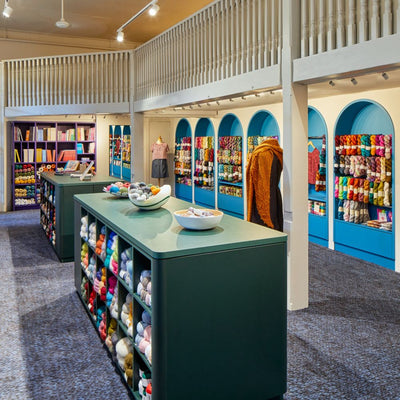Divided by a common language
November 18 2011 – thisisknit
 Once upon a time in Dublin, there was a little crocheter. A lady called Kathleen taught her how to chain, and how to do doubles and trebles, and she made lots of things from patterns. She had heard that in America they used different words for the stitches. But that didn't matter, because she was living in Ireland and America was a place on TV. When was she ever going to be using an American pattern?
Then they invented the internet.
It's like petrol and gasoline. The things are the same, but the words are different. When you know what the equivalences are, then you can use any pattern from anywhere in the English-speaking world and your crochet horizons widen greatly. But if you don't know how to navigate the two systems, patterns using the unfamiliar one just won't work. So here's how to translate from one to the other.
Let's call the two systems US and UK, though the latter includes Australia, South Africa, Ireland and so on. Put very simply, the stitch that the UK calls a double, the US calls a single, and the stitch that the UK calls a treble, the US calls a double. A UK double treble is a US triple. There's absolutely no difference at all in how the stitches are made, though - the only difference is the names.
Any stitch whose name is made up from these will also differ. So an UK half treble will be a US half double, and a UK linked triple treble (like those in the Dublin Bay shawl) is a US linked triple double.
That's the easy part. It can seem a bit complicated when you're trying to find out which system's being used. So here's some tricks that might help if the designer doesn't tell you (some like Aoibhe NÃ do).
The first thing is to check where the pattern's published. If it's published in the US, it will use US terminology; if in the UK, it'll be UK. The spelling conventions can help you too: look for words like "color". Spotting UK spellings like "colour" isn't foolproof, though, because Canadian English hass them but increasingly uses US crochet terminology.
If there's a picture of the stitch pattern, that will help hugely. Doubles and trebles differ so much in their appearance that it's very easy to see which is which. The smaller green swatch at lower right above is UK double, the larger pink one is UK treble.
But what if you've downloaded a pattern from the web with no picture and no indication of where it was written, what can you do? There's two big clues that will tell you. You can use the first clue if the pattern states its tension over either doubles or trebles. UK doubles (US singles) are almost as tall as they are wide, so if you come across a stitch/row ratio which makes a 10cm square with numbers like, say, 17 stitches and 20 rows or 20 stitches and 22 rows, then you're dealing with UK doubles. (Actually, if the pattern's talking about tension rather than gauge, it's probably a UK pattern in any case, though this isn't foolproof.)
UK trebles (US doubles) are much taller, so the ratio of stitch to row is very different. If your pattern states a tension over doubles with half(ish) as many rows as stitches (19 stitches and 10 rows, for example), then it's talking about US doubles, or UK trebles.
If the pattern doesn't mention tension at all, then you're still not stuck. Since the actual stitches don't differ, UK doubles/US singles are the same thing and need the same number of turning chain (1 chain). In the same way, UK trebles/US doubles need 3 turning chain. So if you come across a row instruction that reads "Ch 3, sk first dc, dc in each ch across, ending with dc in third chain of turning chain", the three turning chain tell you that you're dealing with UK trebles/US doubles. Similarly, an instruction that tells you to "ch 1, 1 dc into 1st st, 1 dc in each st to end" is telling you to make UK doubles/US singles, because of that one turning chain at the beginning.
Now, if there were only enough time to make all the crochet patterns we want to....
One more thing to mention: last week we announced next Thursday's Opening Party and Louisa Harding's Drop In Workshop next Friday. Both of these are now up on the booking system and bookable. The booking page for the party is at this link - there's no charge, but it would make the Health and Safety people happier if we had an idea of how many of you to expect, so please register to tell us.
Louisa's workshop is bookable at this link. Though it's from 12.00 noon to 3.00pm, you can drop in for as little or as much time as you like, and the cost is just the price of the skein of yarn for the project.
We're looking forward enormously to both events - it would be lovely to see you there too!
Once upon a time in Dublin, there was a little crocheter. A lady called Kathleen taught her how to chain, and how to do doubles and trebles, and she made lots of things from patterns. She had heard that in America they used different words for the stitches. But that didn't matter, because she was living in Ireland and America was a place on TV. When was she ever going to be using an American pattern?
Then they invented the internet.
It's like petrol and gasoline. The things are the same, but the words are different. When you know what the equivalences are, then you can use any pattern from anywhere in the English-speaking world and your crochet horizons widen greatly. But if you don't know how to navigate the two systems, patterns using the unfamiliar one just won't work. So here's how to translate from one to the other.
Let's call the two systems US and UK, though the latter includes Australia, South Africa, Ireland and so on. Put very simply, the stitch that the UK calls a double, the US calls a single, and the stitch that the UK calls a treble, the US calls a double. A UK double treble is a US triple. There's absolutely no difference at all in how the stitches are made, though - the only difference is the names.
Any stitch whose name is made up from these will also differ. So an UK half treble will be a US half double, and a UK linked triple treble (like those in the Dublin Bay shawl) is a US linked triple double.
That's the easy part. It can seem a bit complicated when you're trying to find out which system's being used. So here's some tricks that might help if the designer doesn't tell you (some like Aoibhe NÃ do).
The first thing is to check where the pattern's published. If it's published in the US, it will use US terminology; if in the UK, it'll be UK. The spelling conventions can help you too: look for words like "color". Spotting UK spellings like "colour" isn't foolproof, though, because Canadian English hass them but increasingly uses US crochet terminology.
If there's a picture of the stitch pattern, that will help hugely. Doubles and trebles differ so much in their appearance that it's very easy to see which is which. The smaller green swatch at lower right above is UK double, the larger pink one is UK treble.
But what if you've downloaded a pattern from the web with no picture and no indication of where it was written, what can you do? There's two big clues that will tell you. You can use the first clue if the pattern states its tension over either doubles or trebles. UK doubles (US singles) are almost as tall as they are wide, so if you come across a stitch/row ratio which makes a 10cm square with numbers like, say, 17 stitches and 20 rows or 20 stitches and 22 rows, then you're dealing with UK doubles. (Actually, if the pattern's talking about tension rather than gauge, it's probably a UK pattern in any case, though this isn't foolproof.)
UK trebles (US doubles) are much taller, so the ratio of stitch to row is very different. If your pattern states a tension over doubles with half(ish) as many rows as stitches (19 stitches and 10 rows, for example), then it's talking about US doubles, or UK trebles.
If the pattern doesn't mention tension at all, then you're still not stuck. Since the actual stitches don't differ, UK doubles/US singles are the same thing and need the same number of turning chain (1 chain). In the same way, UK trebles/US doubles need 3 turning chain. So if you come across a row instruction that reads "Ch 3, sk first dc, dc in each ch across, ending with dc in third chain of turning chain", the three turning chain tell you that you're dealing with UK trebles/US doubles. Similarly, an instruction that tells you to "ch 1, 1 dc into 1st st, 1 dc in each st to end" is telling you to make UK doubles/US singles, because of that one turning chain at the beginning.
Now, if there were only enough time to make all the crochet patterns we want to....
One more thing to mention: last week we announced next Thursday's Opening Party and Louisa Harding's Drop In Workshop next Friday. Both of these are now up on the booking system and bookable. The booking page for the party is at this link - there's no charge, but it would make the Health and Safety people happier if we had an idea of how many of you to expect, so please register to tell us.
Louisa's workshop is bookable at this link. Though it's from 12.00 noon to 3.00pm, you can drop in for as little or as much time as you like, and the cost is just the price of the skein of yarn for the project.
We're looking forward enormously to both events - it would be lovely to see you there too!


1 comment
Well, that explains why I had to add an extra, er, third or so of blanket to this blanket I’m working on. Good to know!